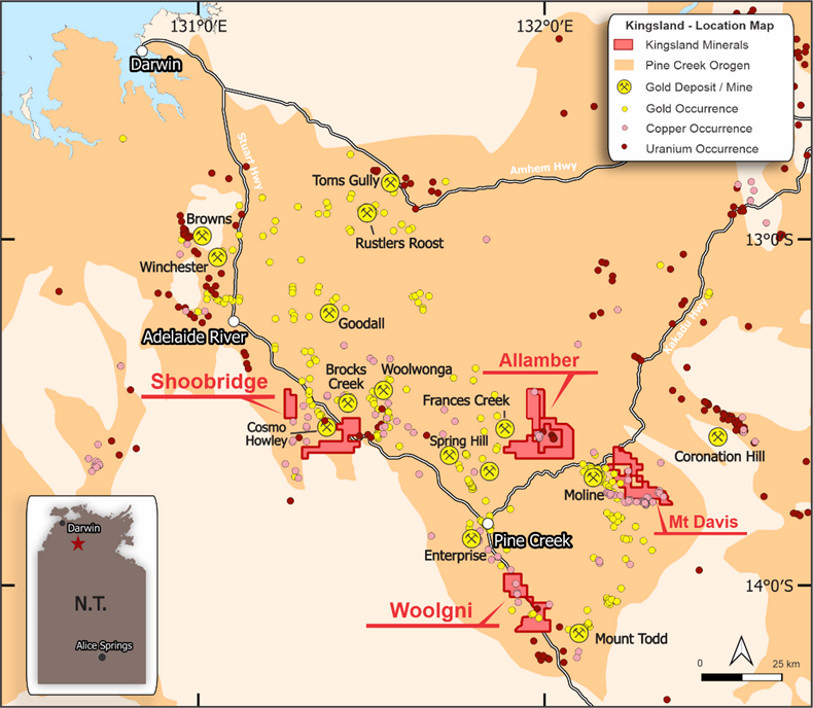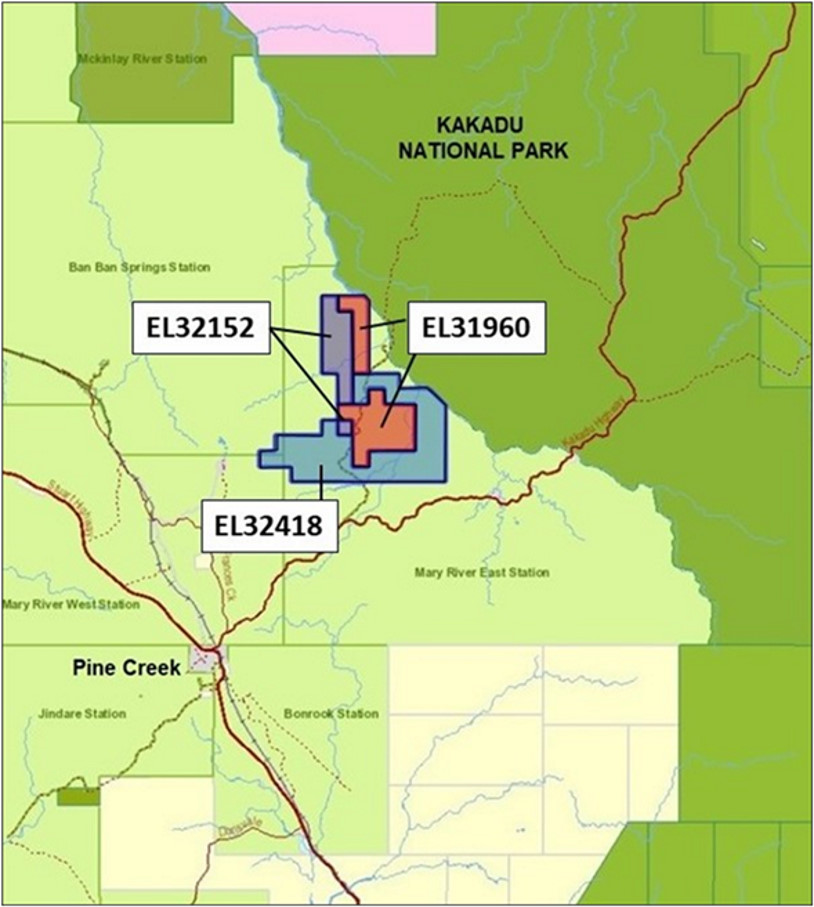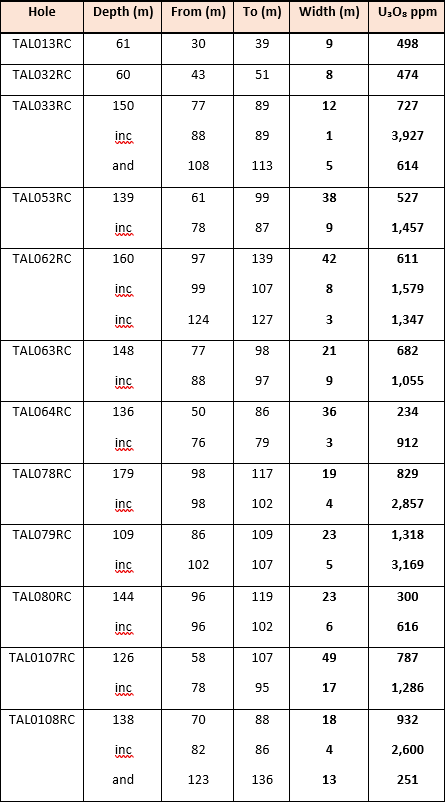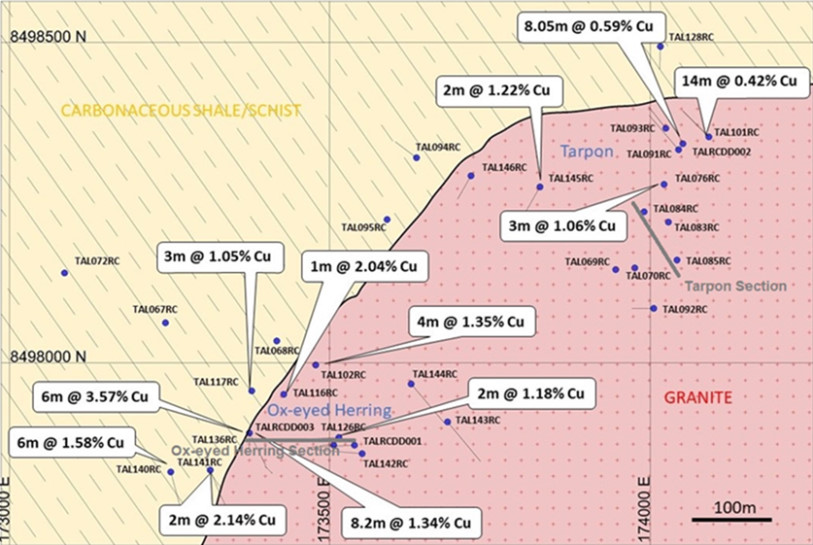Project Overview
Each of the Allamber Project, Woolgni Project, Shoobridge Project and Mt Davis Project and are located within the central part of the Pine Creek Orogen (PCO) in the Northern Territory (200km south of Darwin).

The Allamber Project consists of three of the eight NT Tenements (EL32152, EL31960 and EL32418), is accessed via the Kakadu Highway from Pine Creek and is prospective for copper and uranium mineralisation.

Figure 1: Location of Allamber Project Tenements
The Allamber Project is located within the central part of the PCO which is a tightly folded sequence of Palaeoproterozoic rocks, >4km in thickness, laid down on granitic and gneissic Archaean basement unconformably. The sequence is dominated by clastic, carbonate and carbonaceous sedimentary volcanics. It hosts significant uranium mineralisation in the south at Cleo’s and Cliff South. In addition, it also contains some occurrences of base metals plus gold mineralisation, such as Hatrick and Nipper and Ox-Herring prospects (Figure 2) which were subject to major exploration activity by Element 92 Pty Ltd. It may be noted that entire granite – sediment contact within the Project area is marked by the presence of copper anomalism and has returned significant assay results from Hatrick, Nipper, Tarpon and Ox-Eyed Herring prospects.

Figure 2: Geology of Allamber Project (source: Kingsland Minerals)
Uranium was discovered in the early 1980’s through aerial radiometric surveys followed by ground reconnaissance. Subsequent drilling in the mid 1980’s at the Twin and Dam prospects resulted in the estimation of a non-JORC compliant Mineral Resource at these prospects.
Exploration for uranium recommenced in 2007 when Atom Energy Limited (Atom Energy) (ASX:AXY) acquired the Project. Atom Energy decided to re-drill parts of the Twin and Dam deposits to obtain empirical assay data upon which to base an updated Mineral Resource estimate. Drilling commenced in mid-2007 with 91 reverse circulation (RC) holes totalling 5,275m completed. Drilling was limited to 60m down-hole depth. On the basis of this additional in-fill drilling, Atom Energy contracted Coffey Mining to estimate a Mineral Resource estimate, reported in accordance with the JORC Code (2004). This estimate was completed early in 2008 and only used the assay data from the Atom Energy RC drilling. Atom Energy changed focus soon after and in mid-2009 joint ventured the Project to Thundelarra Exploration Limited (Thundelarra) (ASX:THX).
Thundelarra re-commenced exploration in 2010. Drilling to the west of the Twin deposit intersected uranium and copper mineralisation and this was subsequently named the Lucas prospect. In addition, Thundelarra discovered significant uranium mineralisation at Cliff South. Significant results from this drilling program are presented in the table below.

In September 2011, Thundelarra announced the discovery of a significant copper/silver deposit at Hatrick. This marked a change in focus from uranium to copper exploration due to the declining uranium price.
Drilling for copper focussed on the previously delineated contact zone between the Cullen Granites and the Masson Formation. This had been the focus of previous exploration by Aztec Mining in 1992. Drilling was generally confined to the previously discovered Hatrick prospect and the newly discovered Ox-Eyed Herring prospect. Several holes were also drilled along the granite/sediment contact zone where geochemical anomalies had been previously delineated. Significant drilling results at Ox-Eyed Herring and Tarpon are presented in Figure 3.

Figure 3: Significant Copper Drill Intersection Ox-eyed Herring and Tarpon
The Company is proposing to expand upon the current mineralised footprint at the Cleo Uranium Project. Additional drilling, both along strike and at depth is warranted based on historic drilling results. The aim of this drilling is to expand the extents of known uranium and/or copper mineralisation at Twin, Dam and Cliff South.
Additional geophysical surveys are proposed along the granite/intrusive contact to test for the presence of massive sulphide mineralisation containing copper. Previous drilling had intersected such sulphides and the Independent Geologist considers there is potential to delineate additional sulphide mineralisation.

